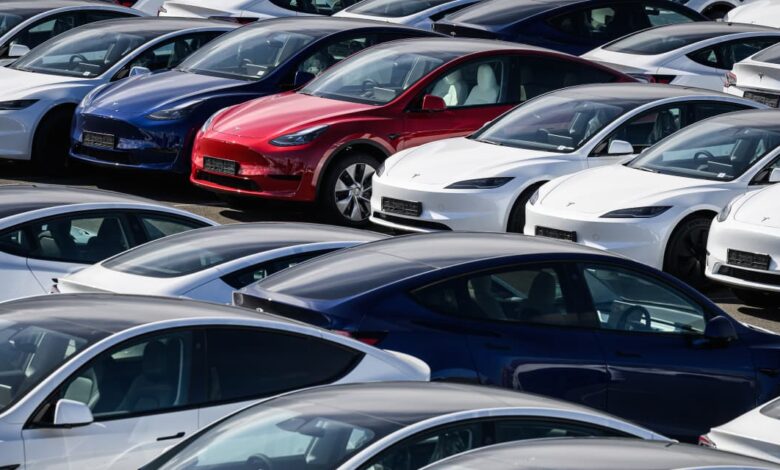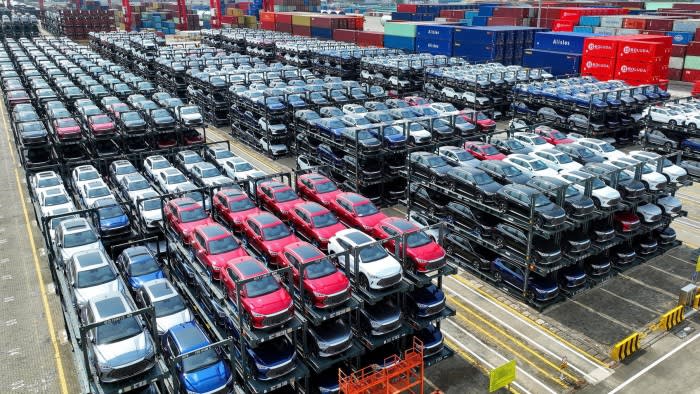Why Is Tesla Stock Up After the Earnings Miss? Elon Musk Fixed a Big Mistake.

Tesla’s quarterly results, combined with recent impressive stock market gains for traditional car companies, were supposed to signal a repudiation of electric vehicles by investors as a whole.
Things turned out a little differently, with the results repudiating something else: lousy strategic planning by
and others.
Tesla is no longer in growth mode. First-quarter earnings per share of 45 cents fell by almost half year over year. Still, shares rose more than 12% after the results were released. Earnings were simply better than feared with some analysts projecting EPS as low as 20 cents.
The stock was up 9.6% in midday trading at $158.57 a share, while the
and
fell 0.4% and 0.2%, Shares traded as high as $167.97, up almost 16%, which would have been the best since March 9, 2021, when shares rose 19.6%.
Tesla’s move to change its product lineup, however, was a bigger reason the stock jumped, clawing back some of the 42% year-to-date loss. The company said it is accelerating the “launch of new models ahead of our previously communicated start of production in the second half of 2025.”
Advertisement – Scroll to Continue
Translation? The long-awaited and lower-priced Tesla, typically called the Model 2, is coming sooner than expected. And, importantly, the vehicle will be the company’s most urgent priority.
“The quarter was a disaster, but that was well known,” says Wedbush analyst Dan Ives. “The big [takeaway] is that Tesla is not focused solely on autonomy/robotaxis and [is] accelerating the lower-cost Model 2 vehicle…finally, a smart strategic plan Street wants to see.”
The strategic shift will “mollify investors,” wrote Bernstein analyst Toni Sacconaghi in a Wednesday report, adding “Can Tesla really deliver significant new models in less than one year?”
Advertisement – Scroll to Continue
That is the new challenge for Musk, who has delayed a cheaper vehicle for years. He developed the massive, high-price Cybertruck before working on a lower-priced car. He also preferred to develop a robotaxi before the Model 2, according to Walter Isaacson’s biography of the CEO.
Part of Musk’s reasoning for that strategic direction was a belief that Tesla could sell millions of $40,000 to $50,000 battery-electric vehicles a year.
Things haven’t turned out that way, but there was a time when the logic made more sense. In 2021 and 2022, Tesla could sell every vehicle it produced at seemingly any price.
Advertisement – Scroll to Continue
Then other auto makers adopted a similar strategy, targeting higher-end buyers and leaving the non-Chinese auto industry with a glut of higher-priced EVs, a dearth of affordable models, and stagnant EV penetration of new-car sales.
China is a different story. Penetration of battery-electric vehicles in new-car sales is already close to 25% in the country. But competition is fierce with dozens of models at all price points battling it out for market share. What’s more, most of the EV growth in China forecast by Citi analyst Jeff Chung for 2024 and 2025 comes from vehicles priced under $30,000, where Tesla doesn’t have an offering.
Non-Chinese buyers, left with few options for cheap EV models, flocked to hybrids. In the first quarter, U.S. and Europe sales of traditional and plug-in hybrid models hit almost 1.7 million units, up about 24% year over year. Battery electric vehicle sales came in at about 710,000 units, up about 5% year over year.
The slowdown in sales of battery-electric vehicles hasn’t hit traditional auto makers making the transition to EVs as hard. Through Tuesday trading, the average year-to-date gain for shares of
and
Advertisement – Scroll to Continue
—which is focused on hybrids, not EVs—has beaten Tesla stock by roughly 60 percentage points.
“While EVs are the future, it’s the [internal combustion engine] product that generates the profits and funds the dividends and buybacks,” wrote Morgan Stanley analyst Adam Jonas in a March report, adding a slowdown in EV sales offers an opportunity for traditional auto makers. They can delay their EV plans and spend less developing them while cash flow from the traditional car business continues to roll in.
GM’s first-quarter earnings demonstrated this. Its corporate operating profit per car came in at about $4,300 despite any opaque EV losses embedded in the numbers. Tesla generated corporate operating profit per vehicle of about $3,000, down from almost $6,300 a year ago.
Advertisement – Scroll to Continue
GM and Ford aren’t off the strategic hook, though. The latter is expected to lose $5.5 billion in its EV business in 2024 after losing $4.7 billion in 2023. The situation at GM would likely be similar, but investors don’t have as detailed figures as they do for Ford, which decided to report its EV business as a separate segment in 2023.
Ford’s losses, which work out to tens of thousands of dollars per EV sold, aren’t that bad, Freedom Capital Markets analyst Mike Ward said. That figure includes relatively high R&D spending and capital charges. It costs billions to develop and build cars. Few, if any, traditional car makers can boast the scale needed to earn a reasonable EV profit yet.
Ward doesn’t believe EVs are dead. Instead, he thinks Ford and GM are making a mistake by trying to build a better Tesla Model Y and adding to the glut of higher-priced EVs. He would prefer to see the pair focus their strategies on where their franchises are strongest: trucks and commercial fleets.
In “the commercial market, compelling use case and social pressures will move [EV penetration] towards that 35% level over the next 5 to 10 years,” says Ward, adding “I’d rather see both companies invest in battery electric vehicles rather than the acquisition spree of the 1990s.”
If all light vehicles move toward a 35% penetration level, roughly 35 million to 40 million battery-electric vehicles could be sold in 2030, up about fourfold compared with 2023.
There is still EV growth out there—and enough of it for several auto makers to enjoy. It just requires the right strategy.
Write to Al Root at allen.root@dowjones.com



